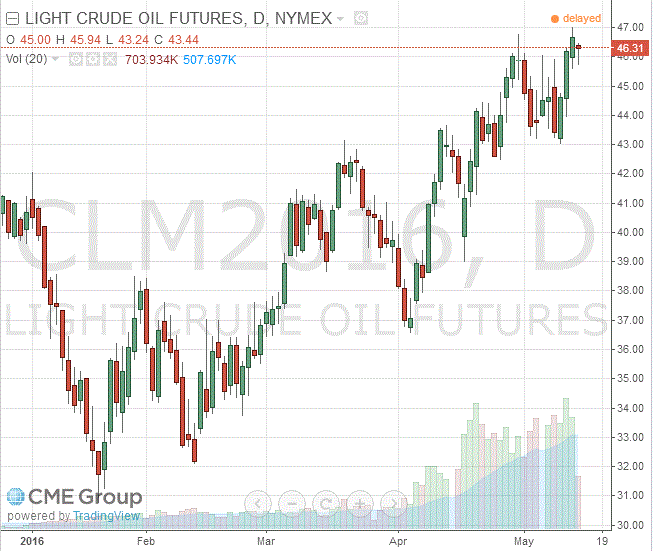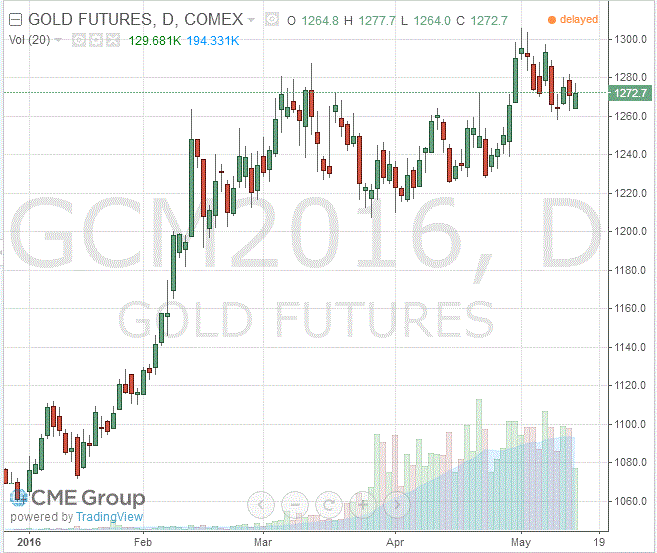Noticias del mercado
-
17:42
Oil prices fell slightly
Quotes oil futures are down again, ending a three-day rally, due to the rise in price of the dollar and partial profit-taking by some investors.
"I would like to mention last fall to lock in profits after three days of strong growth In addition, investors are gradually preparing for a long weekend.", - Said Carsten Fritsch, analyst at Commerzbank. On Monday, markets in many European countries, including Germany and France, will be closed for a public holiday.
Further reduction of prices holding back the news from Nigeria, where, due to supply disruptions of oil production fell to 22-year low. Minister of Finance of Nigeria said that the country's oil production fell to 1.65 million barrels per day from 2.2 million barrels per day before the failure.
The decline in production in Nigeria added to ongoing problems in Canada, where forest fires have led to the closure of a number of oil facilities. "Forest fires have led to the temporary reduction of production by 1.4 million barrels per day, but the facilities do not seem to have suffered Activity is starting to recover, but we believe that in order to restore production take weeks.", - The experts at Jefferies.
Little influenced by a report from the Organization of Petroleum Exporting Countries (OPEC). As it became known, OPEC kept its forecast for global oil demand in 2016, which is expected to grow by 1.2 million barrels per day to 94.18 million barrels per day. In 2015, according to estimates, the demand for oil in the world increased by 1.54 million barrels per day to 92.98 million barrels. In particular, demand for oil in China in 2015 increased by 0.37 million barrels per day in 2016 is expected to increase by 0.28 million barrels per day. In 2016, as the experts expect production in countries outside OPEC will decline by 0.74 million barrels per day (figure revised to 10 th. Barrels per day downward) to 56.4 million barrels a day.
WTI for delivery in June fell to $46.31 a barrel. Brent for June fell to $47.81 a barrel.
-
17:21
Gold shows a slight increase
Gold has risen in price by a percentage amid falling European shares, but then lost almost all positions due to the significant strengthening of the US dollar.
The dollar had on the US data pointed to the improvement of the economic situation in the country. The Commerce Department reported that retail sales in April recorded their biggest gain in a year, as the Americans have stepped up purchases of cars and a number of other goods. Retail sales rose 1.3 percent last month. The data for March were revised, and showed a decline of 0.3 percent instead of falling 0.4 percent previously reported. Excluding cars, gasoline and building materials and services to the food, retail sales jumped 0.9 percent last month after a revised towards strengthening 0.2 percent in March. Economists had forecast retail sales growth of 0.7 percent and core retail sales by 0.3 percent last month. Recall, the economy grew by 1.4 percent in the fourth quarter.
The decline in gold prices is also due to the recent statements by the Fed that the Fed should raise rates if the data point to an improving economy. Boston Fed President Eric Rosengren said that he expects the US economy to accelerate growth in the 2nd quarter of this year, which should provide conditions for new Fed raises interest rates. However, Rosengren did not comment on their expected timing of the next rate hike. He again warned that financial markets are likely to underestimate the number of probable interest rate hikes by the central bank.
Meanwhile, the president of the Federal Reserve Bank of Kansas City, Esther George said that interest rates are at very low levels, given that the economy is close to full employment, and inflation close to the target level of the Central Bank is 2%. George also said that maintaining interest rates at extremely low levels creates negative conditions in the economy.
In addition, it became known that the gold reserves in the largest gold ETF-SPDR Gold Trust fund amounted to 27.17 million on Thursday. Ounces, which is the highest value since November 2013.
Since the beginning of the year the price of gold has increased by 20 per cent against the backdrop of the US series of weak economic data, and other countries, which have reduced the likelihood of the Fed raising interest rates in the short term. Recall, higher interest rates have a downward pressure on the price of gold, which brings its holders to interest income and that is difficult to compete with the assets, bringing that income against the background of increasing interest rates.
The cost of the June gold futures on the COMEX rose to $ 1272.7 per ounce.
-
17:16
New loans in China decline to 555.6 billion yuan in April
The People's Bank of China (PBoC) released its new loans data on Friday. New loans in local currency in China were 555.6 billion yuan in April, down from March's 1,370.0 billion yuan.
M2 money supply jumped by 12.8% year-on-year in April.
Total social financing decreased to 751 billion yuan in April from 2.34 trillion yuan in March.
-
16:51
OPEC’s monthly report: OPEC’s output climbs in April
The Organization of the Petroleum Exporting Countries (OPEC) released its monthly report on Friday. OPEC's output climbed by 188,000 barrels per day (bpd) to 32.44 million bpd in April, according to the report. The increase was driven by higher output from Iran.
Iran's oil production rose by 198,000 bpd to 3.45 million bpd in April.
Supply from non-OPEC members is expected to fall by 745,000 bpd in 2016 compared to the last year, while the U.S. oil output is expected to decline by 431,000 bpd.
Global oil demand is expected to climb by 1.20 million bpd in 2016, unchanged from March, OPEC noted.
OPEC noted that investments in exploration and production between 2016 and 2018 would be less than half of investments during 2012 to 2014.
OPEC also said that the global oil oversupply remained.
"Not much has fundamentally changed as the oversupply remains and global oil inventories are at record highs. But investors hope strong demand, particularly for gasoline, ahead of the US driving season and weaker non-OPEC production will help work down excess supply," OPEC noted.
-
10:24
Global gold demand totals 1,290 tonnes in the first quarter of 2016
World Gold Council (WGC) said on Thursday that global gold demand totalled 1,290 tonnes in the first quarter of 2016, up by 21% compared to the same period last year. According to WGC, the rise was mainly driven by higher inflows into exchange traded funds (ETFs). Global demand for jewellery dropped by 19% year-on-year in the first quarter, total bar and coin demand rose by 1%, while central banks' and other institutions' demand fell by 3%. Total supply rose by 5% to 1,135 tonnes in the first quarter.
-
01:05
Commodities. Daily history for May 12’2016:
(raw materials / closing price /% change)
Oil 46.39 -0.66%
Gold 1,264.70 -0.51%
-

